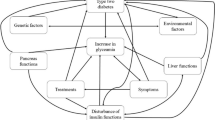Abstract
Interactive computer systems can support their users in problem solving, both in Performing their work tasks and in using the systems themselves. Not only is direct support for heuristics beneficial, but to do so modifies the form of computer support provided. This Paper defines and explores the use of problem solving heuristics in user interface design.
A demonstration hypertext system, Hyperwriter, was developed as the outcome of considering general problem solving heuristics as goals of interactive systems design. Whereas hypertext joins and relates ideas, Hyperwriter additionally, and as a direct outcome of the design approach, has ways of separating, ordering and polishing ideas. As an application for creative writing, Hypertext supports effective thinking over a period of time. (This paper was drafted, organised and re-organised using the system itself.) Some issues arising in implementing Hyperwriter are also discussed.
Similar content being viewed by others
References
E. de Bono (1992),Teach Your Child to Think, Viking.
J. D. Bolter (1991),Writing Space, Lawrence Erlbaum Associates.
G. F. Coulouris & H. Thimbleby (1992),HyperProgramming, Addison-Wesley.
W. V. Costanzo (1989),The Electronic Text: Learning to Write, Read, and Reason with Computers, Educational Technology Publications.
R. Descartes, translated by F. Sutcliffe (1968),Discourse on Method and The Meditations, Penguin.
G. Fischer, A. C. Lemke, T. Mastaglio & A. I. Morch (1991), “The role of critiquing in cooperative problem solving,”ACM Transactions on Information Systems, 9(3), pp123–151.
G. Fischer & B. Reeves (1992), “Beyond intelligent interfaces: Exploring, analysing, and creating success models of cooperative problem solving,”Journal of Applied Intelligence, 1(4), pp311–332.
J. Funke (1991), “Solving Complex Problems: Exploration and Control of Complex Systems,” inComplex Problem Solving: Principles and Mechanisms, edited by R. J. Sternberg & P. A. Frensch, pp185–222, Lawrence Erlbaum.
K. J. Gilhooly (1988),Thinking: Directed, Undirected and Creative, 2nd. ed., Academic Press.
J. Hadamard (1945),The Psychology of Invention in the Mathematical Field, Princeton University Press.
F. Heylighen (1991), “Design of a hypermedia interface translating between associative and formal representations,”International Journal of Man-Machine Studies, 35(4), pp491–515.
P. O'B. Holt & N. Williams, eds. (1992),Computers and Writing: State of the Art, Kluwer Academic Publishers.
P. N. Johnson-Laird (1993),Human and Machine Thinking, Lawrence Erlbaum Associates.
D. E. Knuth (1992), ≪Literate Programming≫, Center for the Study of Language and Information, Stanford University.
B. Laurel (1991),Computers As Theatre, Addison-Wesley.
B. A. Nardi & J. R. Miller (1991), “Twinkling lights and nested loops: distributed problem solving and spreadsheet development,”Computer-supported Cooperative Work and Groupware, edited by S. Greenberg, pp29–52, Academic Press.
T.H. Nelson (1990),Literary Machines 90.1, Mindful Press.
G. Polya (1981),Mathematical Discovery, Combined Edition, John Wiley & Sons.
M-M. Portmann & S. M. Easterbrook (1992), “PMI: Knowledge Elicitation and De Bono's Thinking Tools,” inCurrent Developments in Knowledge Acquisition—EKAW92, edited by Th. Wetter, K-D. Althoff, J. Boose, B. R. Gaines, M. Linster & F. Schmalhofer, pp264–282, Springer Verlag.
R. Rada (1992), “Converting A Textbook To Hypertext,”ACM Transactions on Office Information Systems, 10(3), pp294–315.
C. Runciman & H. Thimbleby (1986), “Equal Opportunity Interactive Systems,”International Journal of Man-Machine Studies, 25(4), pp439–451.
L. A. Suchman (1987),Plans And Situated Actions, Cambridge University Press.
H. Thimbleby (1987), “The Design of a Terminal Independent Package,”Software—Practice and Experience, 17(15), pp351–367.
H. Thimbleby (1988), “Delaying Commitment,”IEEE Software, 5(3), pp78–86.
H. Thimbleby (1990),User Interface Design, Addison-Wesley.
H. Thimbleby (1991), “Can Humans Think?”Ergonomics, 34(10), pp 1269–1287.
H. Thimbleby (1992a), “An Author's Cross-referencer,” inComputers and Writing: State of the Art, edited by P. O'B. Holt & N. Williams, pp90–108, Kluwer Academic Publishers.
H. Thimbleby (1992b), “Heuristics for Cognitive Tools,” in NATO ASI Series F,Proceedings NATO Advanced Research Workshop on Mindtools and Cognitive Modelling, Cognitive Tools for Learning, P.A.M. Kommers, D. H. Jonassen & J. T. Mayes, editors, pp161–168, Springer Verlag.
H. Thimbleby, S. O. Anderson & I. H. Witten (1990), “Reflexive CSCW: Supporting Cooperative Long-Term Personal Work,”Interacting with Computers, 2(3), pp330–336.
H. Thimbleby, S. Jones & A. J. G. Cockburn (1992), “HyperCard: An Object Oriented Disappointment,”Building Interactive Systems: Architectures and Tools, P. D. Gray & R. Took, editors, pp35–55, Springer-Verlag.
L. de Young (1990), “Linking Considered Harmful,” inHypertext: Concepts, Systems and Applications, edited by A. Rizk, N. Streitz & J. André, pp238–249, Cambridge University Press.
T. Winograd & F. Flores (1986),Understanding Computers And Cognition, Ablex.
Author information
Authors and Affiliations
Corresponding author
Rights and permissions
About this article
Cite this article
Thimbleby, H. Designing user interfaces for problem solving, with application to hypertext and creative writing. AI & Soc 8, 29–44 (1994). https://doi.org/10.1007/BF02065176
Issue Date:
DOI: https://doi.org/10.1007/BF02065176




